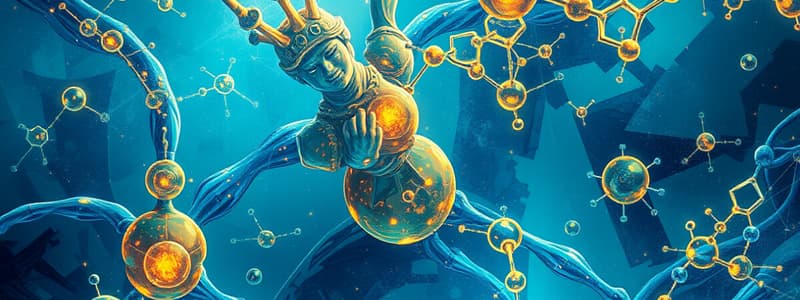Podcast
Questions and Answers
Chemical reactions are driven by changes in energy.
Chemical reactions are driven by changes in energy.
True (A)
Who invented dynamite?
Who invented dynamite?
Alfred Nobel
What type of reaction releases energy?
What type of reaction releases energy?
exothermic
What type of reaction absorbs energy?
What type of reaction absorbs energy?
What is conserved during a chemical reaction?
What is conserved during a chemical reaction?
Which of the following chemicals is used in dynamite?
Which of the following chemicals is used in dynamite?
Dynamite gets its energy from ______.
Dynamite gets its energy from ______.
What happens during an exothermic reaction?
What happens during an exothermic reaction?
Which process absorbs heat?
Which process absorbs heat?
Combustion reactions give off heat, so they are exothermic.
Combustion reactions give off heat, so they are exothermic.
Hand warmers are examples of endothermic reactions.
Hand warmers are examples of endothermic reactions.
Cold packs absorb heat by dissolving salts.
Cold packs absorb heat by dissolving salts.
What type of reaction occurs when sodium reacts with water?
What type of reaction occurs when sodium reacts with water?
For any chemical reaction, the total energy in the reaction remains the same.
For any chemical reaction, the total energy in the reaction remains the same.
Energy changes do not occur during chemical reactions.
Energy changes do not occur during chemical reactions.
Flashcards are hidden until you start studying
Study Notes
Energy in Chemical Reactions
- Chemical reactions are influenced by energy changes, prominently thermal energy.
- Energy changes during reactions and phase transitions help predict reaction feasibility.
- Topics include thermal energy, heat, enthalpy, specific heat, and thermodynamic laws.
Dynamite and Explosive Energy
- Dynamite, invented by Alfred Nobel in 1866, releases significant heat and light energy upon explosion.
- The explosion highlights the potential energy stored in chemical bonds of nitroglycerin (C3H5(NO3)3).
- Chemical reactions can either release or absorb energy, a key element in chemical thermodynamics.
Energy and Mass in Reactions
- Exothermic reactions release energy; endothermic reactions absorb energy.
- Mass is conserved during chemical reactions, ensuring that reactants and products maintain total mass.
Chemical Reactions and Energy Dynamics
- Nitroglycerin becomes explosive due to its unstable nature; mixing with diatomaceous earth allows safe handling.
- The energy release during nitroglycerin decomposition is exemplified in the reaction yielding nitrogen, carbon dioxide, water, and oxygen.
Heat Transfer in Reactions
- Exothermic reactions often result in an increase in surrounding temperature, while endothermic reactions lead to a decrease.
- Combustion reactions are classic exothermic reactions due to heat release.
Changes of State
- Mutual behavior of solids, liquids, and gases determines endothermic and exothermic nature.
- Melting ice is endothermic, absorbing heat; freezing water is exothermic, releasing heat.
Everyday Examples of Reactions
- Hand warmers operate through exothermic reactions involving iron powder oxidation, releasing heat when activated.
- Instant heat packs and cold packs illustrate energy absorption and release through chemical interactions, respectively.
Laws of Energy and Mass
- The total energy in any chemical reaction remains constant, adhering to the law of conservation of energy.
- Energy stored in reactant bonds is crucial for determining the nature of chemical energy changes.
Endothermic and Exothermic Processes
- Endothermic processes absorb heat, including separation of ions and phase changes from solid to gas.
- Exothermic processes, such as combustion and salt formation, release heat, underscoring diverse energy dynamics in chemistry.
Sodium and Water Reaction
- The reaction between sodium and water is notably exothermic, illustrating rapid energy release.
Conservation Principles
- Conservation of mass and energy are crucial concepts, asserting that mass and energy of products equals that of reactants before and after reactions.
Studying That Suits You
Use AI to generate personalized quizzes and flashcards to suit your learning preferences.




